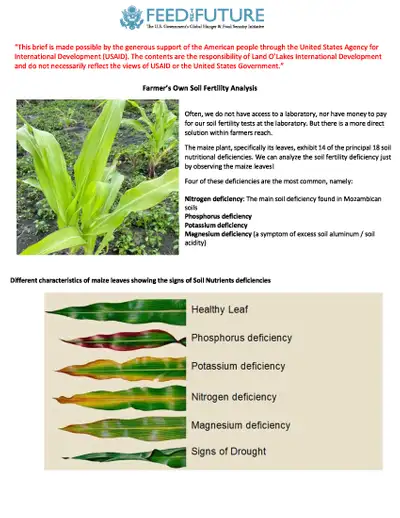Feed the Future Publications
16 Issues in this Publication (Showing 1 - 10) Next
Farmer Own Soil Fertility Analysis
- Also available in:
- Français (fr)
- English (en)
- Español (es)
Four nutrient deficiencies--phosphorus, potassium, nitrogen, and magnesium--can be diagnosed by observing maize leaves. This document includes photos of a healthy maize leaf and of maize leaves demonstrating each of these nutrient deficiencies. It also contains suggestions for how to address each type of deficiency.
“Push and Pull” in Combatting Fall Army Worm and Witchweed (Striga)
- Also available in:
- Français (fr)
- English (en)
- Español (es)
In the Push-Pull system, crops that repel pests and/or attract pests’ predators are intercropped with maize, to ‘push’ pests away from the main crop. Plants that attract pests are planted around the field, to ‘pull’ pests away from the maize. Incorporating legumes in this system means that soil fertility gradually increases over time.
This brief also explains how a farmer in Mozambique managed her pigeon pea plants to repel fall armyworms. She tried sowing maize between pigeon pea plants that, after a previous season’s growth, were cut to a height of 50 cm and allowed to regrow. For reasons explained in the brief, this worked better than starting pigeon pea from seed each season.
Minimal Soil Disturbance and its Effect on Soil Moisture Availability
- Also available in:
- Français (fr)
- English (en)
- Español (es)
This short document contains graphs that show how zero tillage leads to increased water infiltration and increased water retention in soil.
How to Process Jack Bean (& Other Types of Beans) as Human Food
- Also available in:
- Français (fr)
- Español (es)
- English (en)
Jack bean is an excellent plant for enriching soil, because it grows under very difficult conditions. However, the beans contain toxins that normally make them unsuitable for human consumption. This document describes how to germinate jack bean to remove the toxins and increase the beans’ nutrition. Germinated beans also cook more quickly, saving time and money. [Note: Feed the Future also has a more extensive document on this subject, which we hope to summarize in a future issue of EDN.]
Green Manure/Cover Crop approach in RAMA-BC
- Also available in:
- Français (fr)
- English (en)
- Español (es)
This document distinguishes between ‘anchor’ cover crops (that are intercropped with a main crop such as maize) and ‘secondary’ cover crops (that don’t compete with the main crop because they have a short life cycle, and that can help cover the soil at the start of the growing season). The document also includes short summaries of five cover crops: jack bean, pigeon pea, lablab beans, cowpeas, and mung beans.
Inclusive Digital Design Toolkit: Practical Guidance for Feed the Future Activities
Whether you are just starting an activity design or implementation exclusively aimed at developing a new digital tool in Feed the Future activities, or if you are simply planning on using existing digital technology within development programming, this toolkit is for you. This toolkit has been designed to assist USAID staff and implementing partners to design and implement activities that:
- Understand that potential users have complex realities that alter their ability to use, engage with, and benefit from digital tools.
- Overcome the digital divides of access, digital literacy, and offline benefit through inclusive digital design and program activities.
- Utilize a Digital Inclusion Framework to assess and iteratively improve digital inclusion efforts.
Activity Design Guidance for Climate-Smart Agriculture and Food Systems
This document provides guidance for achieving climate change adaptation and mitigation outcomes in Feed the Future activity designs. Since climate change affects all our programming, this guidance relates to achieving outcomes under all the U.S. Governmenty's Global Food Security Strategy(GFSS) objectives and intermediate results, while also safeguarding productivity gains and livelihoods in light of a changing climate and achieving emissions reduction cobenefits.
Activity Design Guidance for Investing in Livestock and Animal Source Food Systems
The livestock sector constitutes 30 percent of the agricultural gross domestic product (GDP) in thedeveloping world, and is one of the fastest-growing sub sectors in agriculture. Investments in livestockproduction and animal source foods (ASF) market systems support the three U.S. Government’s GlobalFood Security Strategy (GFSS) goals of (1) inclusive and sustainable agricultural-led economic growth,(2) strengthened resilience among people and systems, and (3) a well-nourished population, especially women and children.
Designing Effective Nutrition-Sensitive Agriculture Activities - Deck 1
Designing Effective Nutrition-Sensitive Agriculture Activities - Deck 2
Agricultural activities commonly aim to :
- Improve production of target commodities
- Increase income
- Sustain, protect, or enhance productive natural resources
- Engage women and youth to secure their livelihoods









